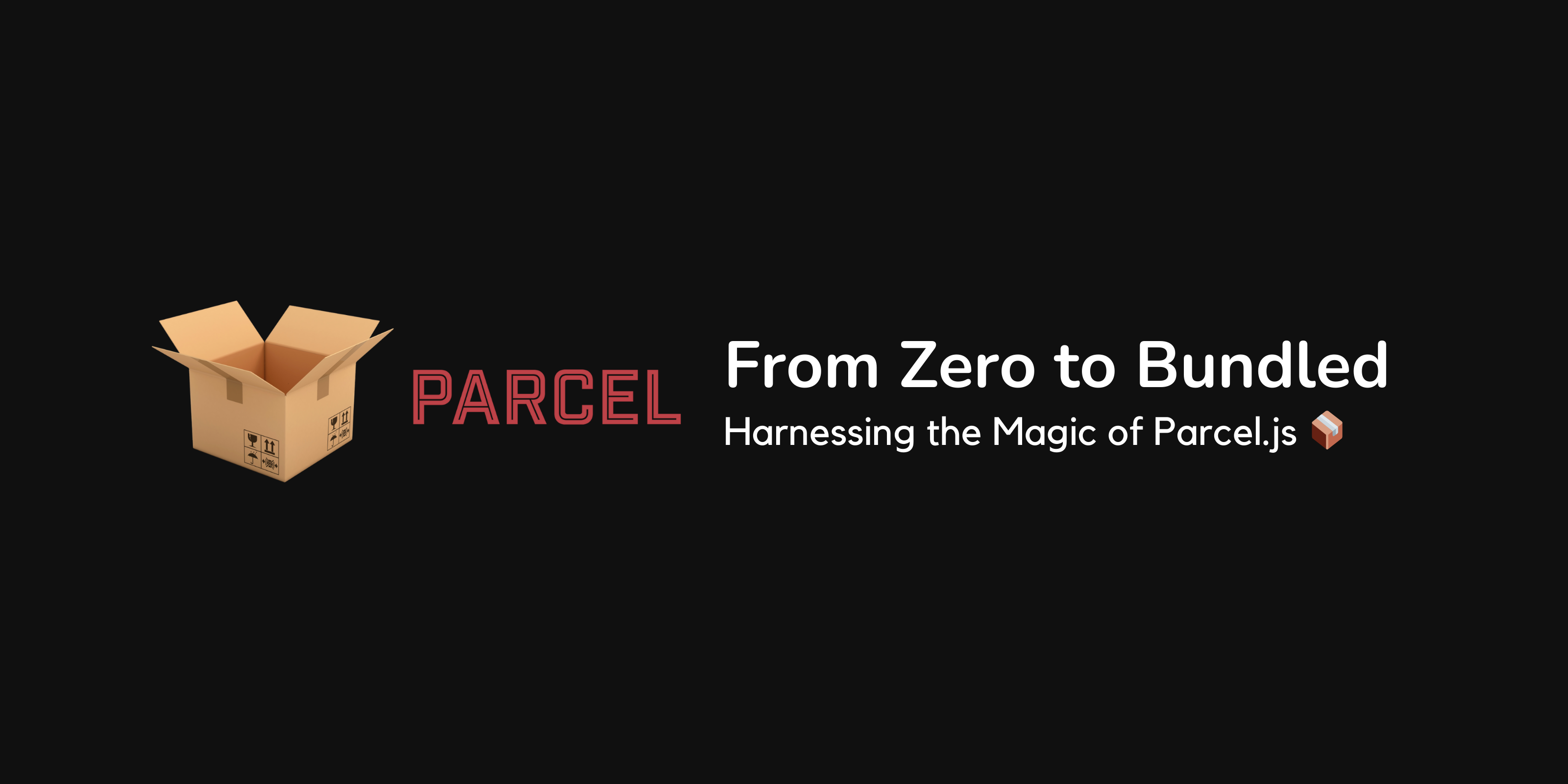From Zero to Bundled: Harnessing the Magic of Parcel.js
 Sarthak Negi
Sarthak NegiTable of contents
- Understanding Parcel JS
- Parcel Features That Set It Apart
- 1. HMR (Hot Module Replacement)
- 2. File Watcher Algorithm
- 3. Minification and Code Cleaning
- 4. DEV and Production Builds
- 5. Super Fast Building Algorithm
- 6. Image Optimization
- 7. Caching During Development
- 8. Compatibility with Older Browsers
- 9. HTTPS in Development
- 10. Port Number Customization
- 11. Consistent Hashing Algorithm
- 12. Zero Configuration
- 13. Automatic Code Splitting
- Uses of Parcel JS
- Significance of Parcel JS

In the ever-evolving landscape of web development, tools that streamline the development process and enhance productivity are invaluable. One such tool that has gained significant attention in recent years is Parcel JS. In this article, we will explore the features, uses, and significance of Parcel JS in modern web development.
Understanding Parcel JS
Parcel JS is a blazing fast, zero-config web application bundler that simplifies the process of building and bundling static assets for web applications. It takes an unconventional approach by requiring minimal configuration, allowing developers to focus more on writing code and less on setting up build tools.
Parcel Features That Set It Apart
1. HMR (Hot Module Replacement)
Parcel.js introduces the concept of Hot Module Replacement (HMR), revolutionizing the way developers interact with their applications during development. HMR allows for real-time updates in the browser as changes are made to the codebase. It accomplishes this by tracking file changes through a sophisticated file watcher algorithm and seamlessly rendering those changes in the application, saving developers time and enhancing productivity.
2. File Watcher Algorithm
Behind the scenes, Parcel.js employs a cutting-edge file watcher algorithm, developed using C++. This algorithm enables Parcel.js to efficiently monitor changes in the project files, ensuring that updates are accurately and swiftly incorporated into the application. This contributes to a seamless development experience.
3. Minification and Code Cleaning
Parcel.js includes built-in minification capabilities, ensuring that your codebase is optimized for production. Moreover, it also automatically cleans up your code, removing unnecessary comments and whitespace, resulting in a leaner and more efficient final bundle.
4. DEV and Production Builds
With Parcel.js, managing different build configurations is a breeze. It provides separate build modes for development (DEV) and production (PROD), allowing you to tailor your build process to suit the specific requirements of each stage. Development builds prioritize speed and debugging, while production builds focus on optimization and performance.
5. Super Fast Building Algorithm
Speed is a hallmark of Parcel.js. Its advanced building algorithm is designed for rapid bundling and compilation of your project. This means shorter waiting times and increased productivity for developers, regardless of the project size.
6. Image Optimization
Parcel.js goes beyond code bundling and includes image optimization. It automatically optimizes images during the build process, reducing file sizes without compromising on quality. This contributes to improved loading times and a better user experience.
7. Caching During Development
Parcel.js implements caching during development, which means that if you make changes to your codebase, only the modified parts will be rebuilt, significantly speeding up the development cycle. This feature is particularly handy when working on larger projects.
8. Compatibility with Older Browsers
In the world of web development, ensuring compatibility across different browsers is crucial. Parcel.js has you covered by generating bundles that are compatible with older browser versions, ensuring a consistent experience for all users.
9. HTTPS in Development
Security is paramount, even during the development phase. Parcel.js makes it easy to run your development server over HTTPS, mimicking a production-like environment and allowing you to test secure connections and protocols.
10. Port Number Customization
With Parcel.js, you have the flexibility to customize the port number on which your development server runs. This is particularly useful in scenarios where a specific port needs to be used due to network or firewall configurations.
11. Consistent Hashing Algorithm
Parcel.js employs a consistent hashing algorithm to generate unique filenames for generated assets. This ensures that assets maintain consistent filenames across builds, making caching and deployment easier to manage.
12. Zero Configuration
One of the standout features of Parcel.js is its zero-configuration setup. Gone are the days of complex configuration files. Parcel.js automatically analyzes your project and sets up everything you need to start bundling right away. This reduces overhead and eliminates the need for a steep learning curve.
13. Automatic Code Splitting
Optimizing load times is crucial for providing an exceptional user experience. Parcel.js includes automatic code splitting, which means that your bundle is intelligently divided into smaller chunks that are loaded only when needed. This leads to faster initial page loads and improved performance overall.
Uses of Parcel JS
1. Single-Page Applications (SPAs)
Parcel JS is well-suited for building SPAs, where smooth and efficient asset bundling is essential. Its code-splitting capabilities help ensure that only the required code is loaded, enhancing the application's performance and user experience.
2. Static Websites
For static websites that need asset bundling, Parcel JS provides a simple and efficient solution. Its zero-configuration setup is particularly beneficial for smaller projects where setting up complex build configurations might not be practical.
3. Prototyping and Rapid Development
During the prototyping and development phase, Parcel JS's HMR feature becomes incredibly valuable. Developers can make instant changes to the code and see the results in the browser without manual refreshes, accelerating the development cycle.
4. Integrating with Modern Frameworks
Parcel JS integrates well with popular modern frameworks like React, Vue.js, and Angular. Its ability to handle various asset types and its seamless dependency management make it an attractive choice for developers working with these frameworks.
Significance of Parcel JS
1. Developer-Friendly
Parcel JS's zero-configuration setup and intuitive features make it highly developer-friendly. It reduces the learning curve for new developers entering the field and allows experienced developers to focus on coding rather than dealing with complex build tool configurations.
2. Speed and Performance
With its efficient code splitting and asset optimization, Parcel JS contributes to improved web application performance. Smaller initial bundles and quick updates during development translate to faster load times and a better user experience.
3. Streamlined Development Workflow
The built-in HMR feature of Parcel JS significantly speeds up the development workflow. Developers can see changes immediately without the need to manually refresh the browser or rebuild the project, leading to more efficient coding and quicker iterations.
4. Adaptability
Parcel JS is versatile and can be used for various types of web projects, from static websites to complex SPAs. Its plugin system allows developers to customize its behaviour when necessary, giving them the flexibility to adapt the tool to their specific requirements.
In conclusion, Parcel JS has emerged as a powerful and user-friendly bundler in the web development landscape. Its zero-config approach, built-in features for asset transformation, code splitting, and HMR make it an excellent choice for developers aiming to streamline their workflow and enhance the performance of their web applications. As web development continues to evolve, tools like Parcel JS play a significant role in enabling developers to build faster, more efficient, and more user-friendly applications.
Subscribe to my newsletter
Read articles from Sarthak Negi directly inside your inbox. Subscribe to the newsletter, and don't miss out.
Written by
